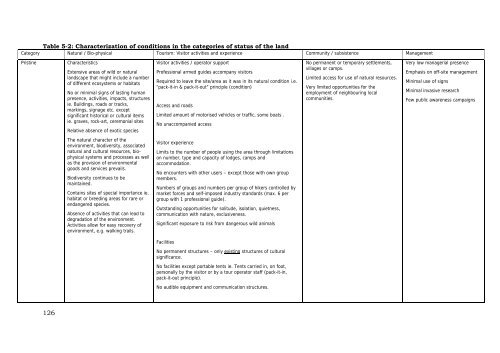Okavango Delta Management Plan - Ramsar Convention on Wetlands
Okavango Delta Management Plan - Ramsar Convention on Wetlands
Okavango Delta Management Plan - Ramsar Convention on Wetlands
Create successful ePaper yourself
Turn your PDF publications into a flip-book with our unique Google optimized e-Paper software.
Table 5-2: Characterizati<strong>on</strong> of c<strong>on</strong>diti<strong>on</strong>s in the categories of status of the land<br />
Category Natural / Bio-physical Tourism: Visitor activities and experience Community / subsistence <str<strong>on</strong>g>Management</str<strong>on</strong>g><br />
Pristine Characteristics<br />
126<br />
Extensive areas of wild or natural<br />
landscape that might include a number<br />
of different ecosystems or habitats<br />
No or minimal signs of lasting human<br />
presence, activities, impacts, structures<br />
ie. Buildings, roads or tracks,<br />
markings, signage etc. except<br />
significant historical or cultural items<br />
ie. graves, rock-art, cerem<strong>on</strong>ial sites<br />
Relative absence of exotic species<br />
The natural character of the<br />
envir<strong>on</strong>ment, biodiversity, associated<br />
natural and cultural resources, biophysical<br />
systems and processes as well<br />
as the provisi<strong>on</strong> of envir<strong>on</strong>mental<br />
goods and services prevails.<br />
Biodiversity c<strong>on</strong>tinues to be<br />
maintained.<br />
C<strong>on</strong>tains sites of special importance ie.<br />
habitat or breeding areas for rare or<br />
endangered species.<br />
Absence of activities that can lead to<br />
degradati<strong>on</strong> of the envir<strong>on</strong>ment.<br />
Activities allow for easy recovery of<br />
envir<strong>on</strong>ment, e.g. walking trails.<br />
Visitor activities / operator support<br />
Professi<strong>on</strong>al armed guides accompany visitors<br />
Required to leave the site/area as it was in its natural c<strong>on</strong>diti<strong>on</strong> i.e.<br />
“pack-it-in & pack-it-out” principle (c<strong>on</strong>diti<strong>on</strong>)<br />
Access and roads<br />
Limited amount of motorised vehicles or traffic, some boats .<br />
No unaccompanied access<br />
Visitor experience<br />
Limits to the number of people using the area through limitati<strong>on</strong>s<br />
<strong>on</strong> number, type and capacity of lodges, camps and<br />
accommodati<strong>on</strong>.<br />
No encounters with other users – except those with own group<br />
members.<br />
Numbers of groups and numbers per group of hikers c<strong>on</strong>trolled by<br />
market forces and self-imposed industry standards (max. 6 per<br />
group with 1 professi<strong>on</strong>al guide).<br />
Outstanding opportunities for solitude, isolati<strong>on</strong>, quietness,<br />
communicati<strong>on</strong> with nature, exclusiveness.<br />
Significant exposure to risk from dangerous wild animals<br />
Facilities<br />
No permanent structures – <strong>on</strong>ly existing structures of cultural<br />
significance.<br />
No facilities except portable tents ie. Tents carried in, <strong>on</strong> foot,<br />
pers<strong>on</strong>ally by the visitor or by a tour operator staff (pack-it-in,<br />
pack-it-out principle).<br />
No audible equipment and communicati<strong>on</strong> structures.<br />
No permanent or temporary settlements,<br />
villages or camps.<br />
Limited access for use of natural resources.<br />
Very limited opportunities for the<br />
employment of neighbouring local<br />
communities.<br />
Very low managerial presence<br />
Emphasis <strong>on</strong> off-site management<br />
Minimal use of signs<br />
Minimal invasive research<br />
Few public awareness campaigns

















